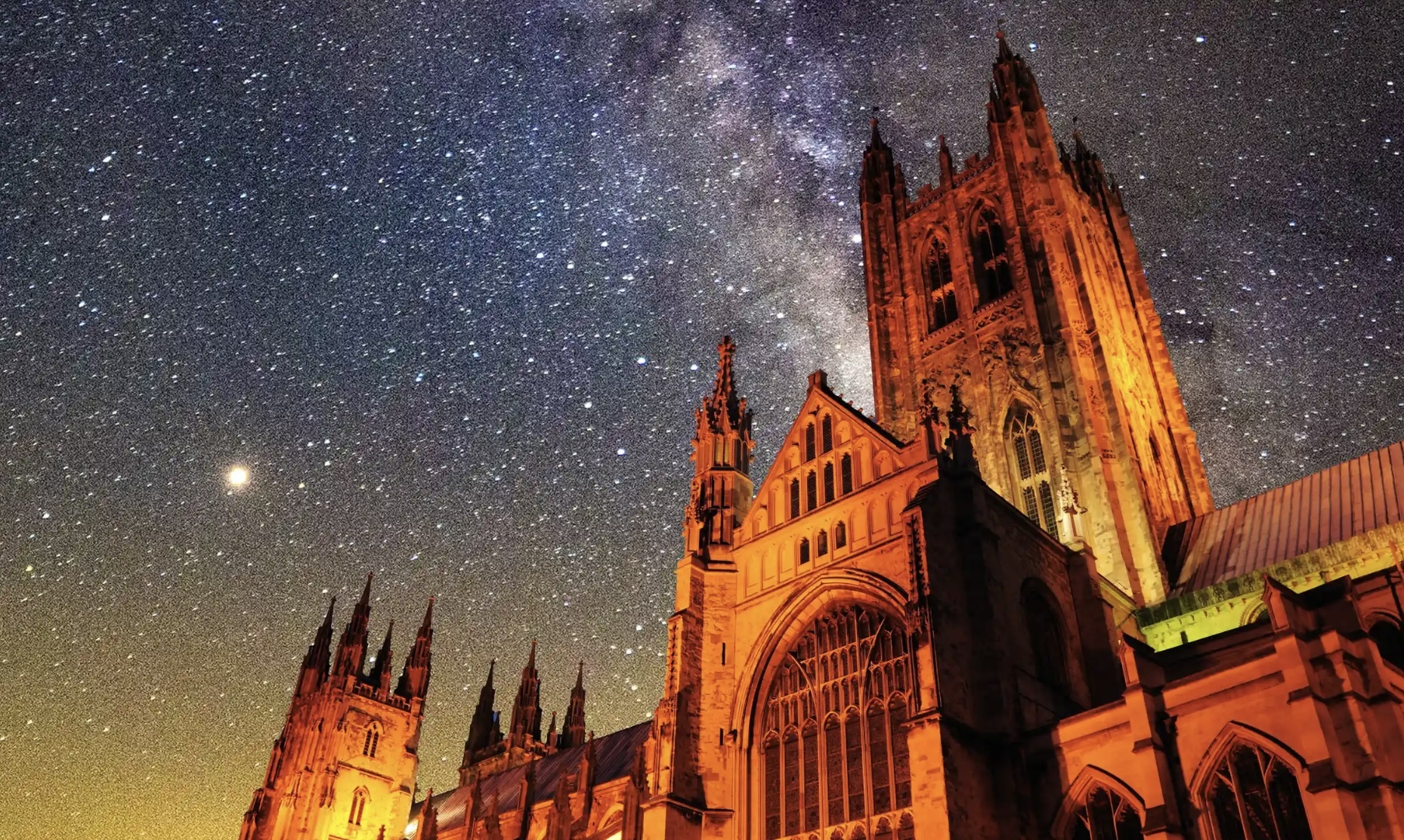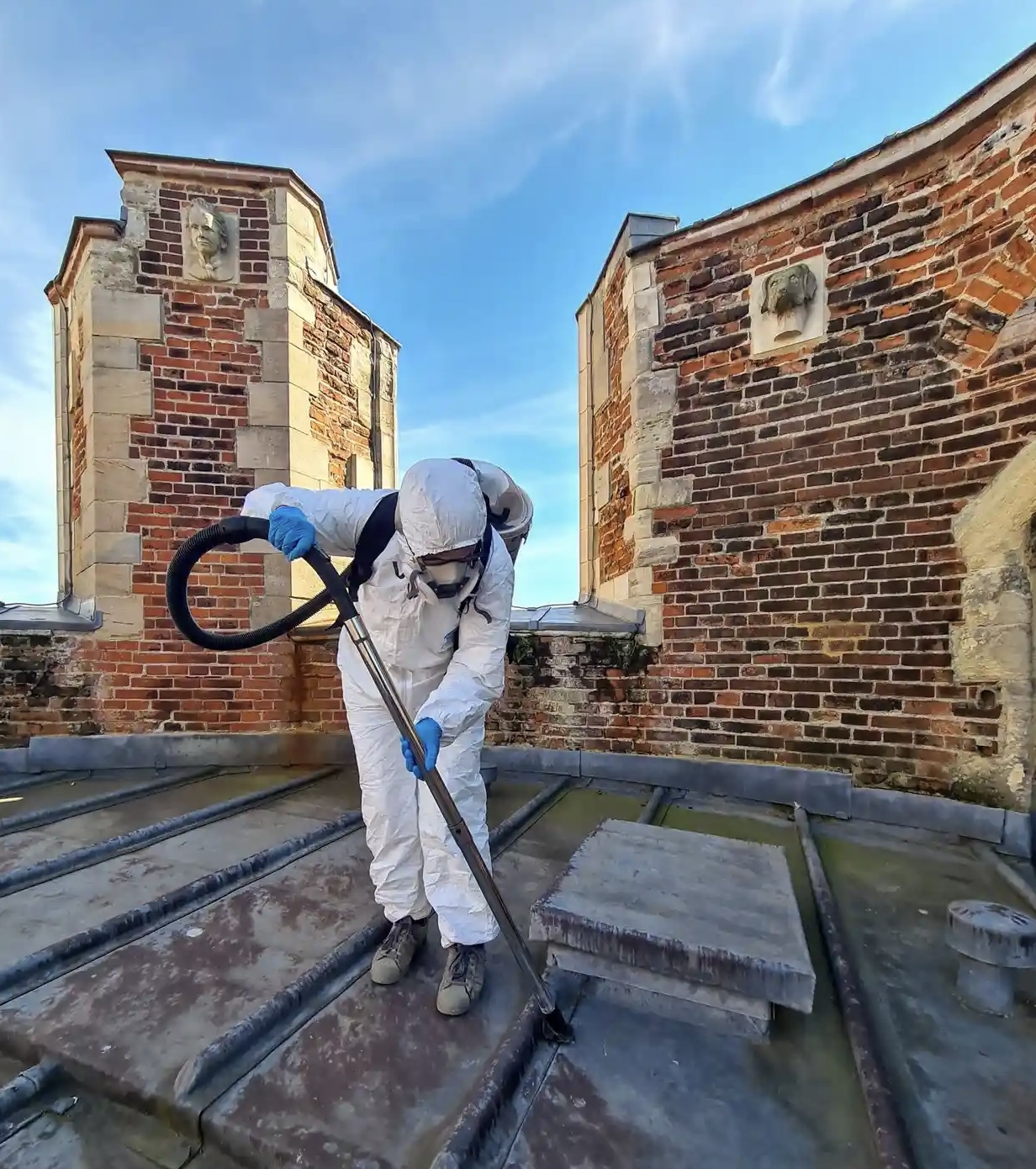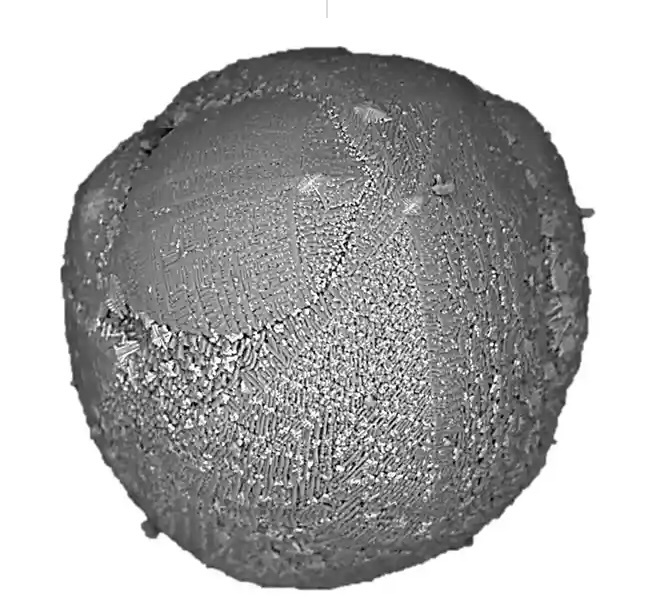19.03.2024

A composite image of Canterbury Cathedral floodlit at dusk and the Milky Way photographed from Mount Olympus in Greece. Photograph: Jonathan Garland/Alamy; Nicolas Economou/NurPhoto/Getty Images
Mini missions are being launched amid the spires – a haven for dust particles that may contain clues about the cosmos and the early Earth
n the roof of Canterbury Cathedral, two planetary scientists are searching for cosmic dust. While the red brick parapet hides the streets, buildings and trees far below, only wispy clouds block the deep blue sky that extends into outer space.
The roaring of a vacuum cleaner breaks the silence and researcher Dr Penny Wozniakiewicz, dressed in hazmat suit with a bulky vacuum backpack, carefully traces a gutter with the tube of the suction machine.
“We’re looking for tiny microscopic spheres,” explains her colleague, Dr Matthias van Ginneken from the University of Kent, also clad in protective gear. “Right now, we are collecting thousands and thousands of dust particles, and we hope there will be a minuscule number that came from space.”
Most of the extraterrestrial dust that bombards Earth each year vaporises in the atmosphere – some models suggest that 15,000 tons reach Earth’s atmosphere (the equivalent of about 75 blue whales). But about 5,200 tons of micrometeorites fall to Earth, based on an estimate from Antarctica. These particles, which most likely come from comets and asteroids, are tiny, between 50 microns to two millimetres in diameter.
“You have to be a bit of a detective,” says Van Ginneken. The extreme heating on atmospheric entry changes many of the minerals and “you have to figure out the nature of the original particle based on the limited information you have”.

Dr Matthias van Ginneken using a backpack vacuum cleaner to gather material from the roof of Canterbury Cathedral. Photograph: Gary Hughes/ University of Kent
Researchers are turning to micrometeorites for clues about the chemistry of asteroids and meteorites. By looking at chemical variants known as isotopes, scientists can understand more about the parent body that the cosmic dust came from – and what happened to it as it entered Earth’s atmosphere.
Also, in the past, cosmic dust was more plentiful, as there were many more collisions between objects in the solar system when the Earth was young. That dust is trapped in rocks, and it can point to what was happening in our planetary neighbourhood through Earth’s history, and how it has changed.
Van Ginneken and Wozniakiewicz are trying to understand how the flux of micrometeorites changes, among other science questions.
“If you can get an understanding as to how many dust particles are arriving over the surface, you can make some estimates as to how much material is arriving at the Earth over time, and therefore, potentially, what contribution space dust is making to the chemistry on the Earth,” says Wozniakiewicz.
“And that’s in two ways – some of [the cosmic materials] survive on the surface, and they can take part in surface chemistry. Some of them burn up in the atmosphere, and they can take part in atmospheric chemistry.”
Micrometeorites can seed elements on to the land and seas which are not common on Earth’s surface, as well as in the atmosphere – which can influence how these systems behave.
Wozniakiewicz and Van Ginneken are looking for a specific type of extraterrestrial dust: cosmic spherols. These tiny spheres are relatively easy to identify compared with other dust, because of their distinctive shape, but it takes a microscope to be certain that a cosmic spherol did not come from Earth. This makes them useful in estimating how much cosmic dust fell in a particular place over a given time period.
It was thought to be impossible to collect cosmic dust in the urban environment – it was confined to pristine places, such as the Antarctic, or in fossilised sediment. But in 2009, Norwegian jazz musician turned cosmic dust hunter Jon Larsen began combing through hundreds of kilograms of urban dust particles, searching for cosmic dust. In 2017, Larsen and colleagues, including Van Ginneken, published a seminal paper in the journal Geology, showing that anybody with a microscope and patience could discover cosmic spheres.
But it is tricky to collect micrometeorites for scientific study, even though they continuously fall on the Earth’s surface. The particles are easily contaminated, which could compromise their use in research. (But that is not why Van Ginneken and Wozniakiewicz look like white-clad aliens – they are protecting themselves from bird flu, possibly contained in the droppings and bird bones we see on the roof.)
Larsen “started the whole era of urban micrometeorites”, says Van Ginneken. “Since then, more and more people have been doing this as a hobby. Part of what Penny and I want to do is bring the science into it.”
Cathedral roofs, such as Canterbury’s, are ideal for cosmic dust hunting, as they are large, inaccessible and largely untouched. We enter through a usually barred wooden door, at the back of the cathedral’s main Trinity Chapel, up hundreds of tightly winding steps, and then through another specially unlocked door to reach one of the cathedral’s roofs. This was Van Ginneken and Wozniakiewicz’s final roof of the day – they had trekked up to several other roofs on the cathedral. They have also collected dust from Rochester Cathedral, and hope to add Salisbury and Winchester to their list.
Van Ginneken is keen to sample many roofs, to understand the biases that creep into urban micrometeorite collections, such as the effect of rainwater. The advantage of roofs is that they are easily accessible, he says. Going to Antarctica, where a lot of micrometeorite research has been undertaken, “is very expensive, it takes a lot of preparation, and there’s a limit on the amount of samples you can bring back”. Also, the research is limited to a specific climate and latitude. Roofs broaden the opportunities to investigate how these tiny dust particles interact in different environments.

One of Dr Matthias van Ginneken’s scans of a micrometeorite. Photograph: Matthias van Ginneken
The abundance of urban micrometeorites also opens up planetary science to those who do not necessarily have access to the haul from larger space missions. And there is increasing interest in the bounties of outer space. Nasa’s OSIRIS-REx mission, for example, last year brought back to Earth material from the asteroid Bennu, which is more than 4.5bn years old.
“Those missions are great,” says Wozniakiewicz. “They go to a single object, and they tell you a lot about that one object. Micrometeorites tell you about thousands, millions of objects… They tell you more about the population of asteroids as a whole, a snapshot of all the different processes, all the different bodies that are out there. And then you can compare those samples, along with meteorites, to the samples that are being brought back from these missions.”
Cosmic dust could also hold clues to our own planet in the distant past, says Dr Martin Suttle, a lecturer in planetary science at The Open University. It could have also created a hospitable environment on early Earth that allowed life to spark spontaneously, according to a new paper published by Suttle and colleagues in Nature Astronomy.
“There was more dust coming to Earth, maybe 1,000 times more dust, than today,” he says. “That dust carries lots of stuff which is attractive as a feedstock for early prebiotic chemistry, things like iron metal, which is otherwise not present on the Earth’s surface.”
But collecting the cosmic dust is only the beginning of the research process, and arguably the easier part – despite all of the cathedral’s stairs. The bags of dust will now be sterilised so that they are safe to work with, and then the scientists will examine each particle under a sterile microscope.
“We will spend hours and hours and hours and hours just extracting spheres and hoping that one is a cosmic spherol,” says Van Ginneken.
Quelle: The Guardian

